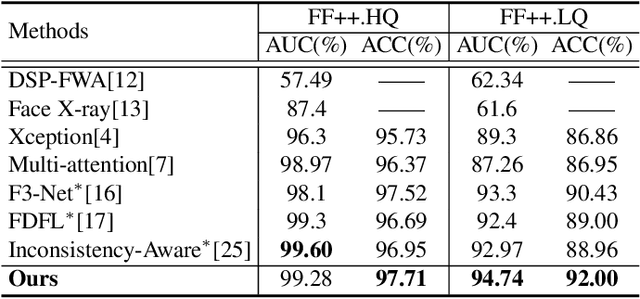Haojie Yuan
UIA-ViT: Unsupervised Inconsistency-Aware Method based on Vision Transformer for Face Forgery Detection
Oct 23, 2022Abstract:Intra-frame inconsistency has been proved to be effective for the generalization of face forgery detection. However, learning to focus on these inconsistency requires extra pixel-level forged location annotations. Acquiring such annotations is non-trivial. Some existing methods generate large-scale synthesized data with location annotations, which is only composed of real images and cannot capture the properties of forgery regions. Others generate forgery location labels by subtracting paired real and fake images, yet such paired data is difficult to collected and the generated label is usually discontinuous. To overcome these limitations, we propose a novel Unsupervised Inconsistency-Aware method based on Vision Transformer, called UIA-ViT, which only makes use of video-level labels and can learn inconsistency-aware feature without pixel-level annotations. Due to the self-attention mechanism, the attention map among patch embeddings naturally represents the consistency relation, making the vision Transformer suitable for the consistency representation learning. Based on vision Transformer, we propose two key components: Unsupervised Patch Consistency Learning (UPCL) and Progressive Consistency Weighted Assemble (PCWA). UPCL is designed for learning the consistency-related representation with progressive optimized pseudo annotations. PCWA enhances the final classification embedding with previous patch embeddings optimized by UPCL to further improve the detection performance. Extensive experiments demonstrate the effectiveness of the proposed method.
Towards Intrinsic Common Discriminative Features Learning for Face Forgery Detection using Adversarial Learning
Jul 08, 2022



Abstract:Existing face forgery detection methods usually treat face forgery detection as a binary classification problem and adopt deep convolution neural networks to learn discriminative features. The ideal discriminative features should be only related to the real/fake labels of facial images. However, we observe that the features learned by vanilla classification networks are correlated to unnecessary properties, such as forgery methods and facial identities. Such phenomenon would limit forgery detection performance especially for the generalization ability. Motivated by this, we propose a novel method which utilizes adversarial learning to eliminate the negative effect of different forgery methods and facial identities, which helps classification network to learn intrinsic common discriminative features for face forgery detection. To leverage data lacking ground truth label of facial identities, we design a special identity discriminator based on similarity information derived from off-the-shelf face recognition model. With the help of adversarial learning, our face forgery detection model learns to extract common discriminative features through eliminating the effect of forgery methods and facial identities. Extensive experiments demonstrate the effectiveness of the proposed method under both intra-dataset and cross-dataset evaluation settings.
 Add to Chrome
Add to Chrome Add to Firefox
Add to Firefox Add to Edge
Add to Edge